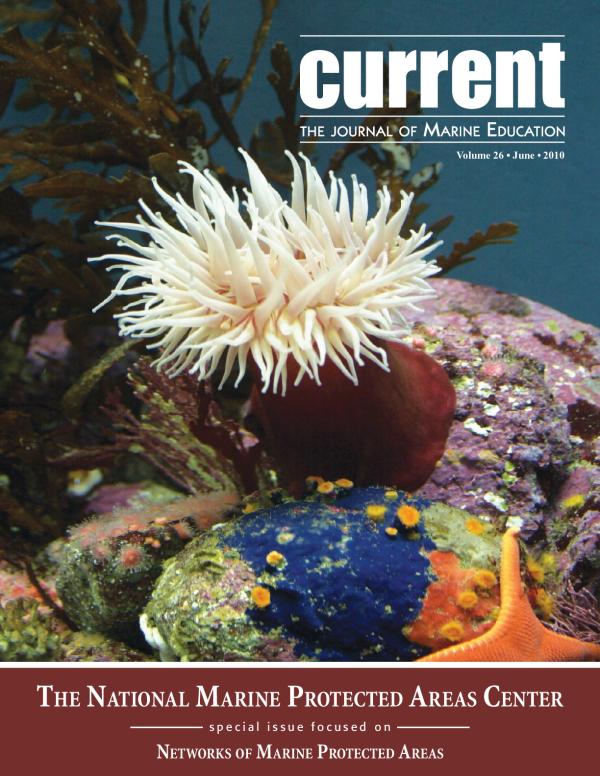Location
SPREP LIBRARY
Publication Year:
2010
Publication Place
Ocean Springs, MS
Physical Description:
45 p.
Call Number
[EL]
Collection
Language
English
Record ID:
37462
Legacy PEIN ID:
77471
General Notes
Special MPA Center sponsored edition of Current: The Journal of Marine Education focused on Networks and Systems of Marine Protected Areas see http://mpa.gov/resources/education/current/
Increasing impacts on the worlds oceans and Great Lakes, caused by development, pollution, overfishing, and natural events, strain the health of our coastal and marine ecosystems. Some of these impacts can include decreased or damaged fish populations, loss of wetlands and other coastal habitats, bleached corals, threatened or endangered species, or resulting social and economic impacts. Marine protected areas, or MPAs, are one type of ocean management tool that, when used effectively, help protect and restore our oceans. They may also protect historic artifacts such as shipwrecks that could otherwise be damaged by handling or theft.
Sometimes a single MPA is not sufficient in size or scope to protect all of the resources that reside within its boundaries. Therefore, a network of MPAs a grouping of smaller MPAs protecting different habitats at various locations within the larger ecosystem - may be required. This issue of Current focuses on networks of MPAs, and includes articles written by authors who have had extensive experience in MPA network management and research. The activities and additional resources at the end of the articles will help you bring the concept of MPAs and networks of MPAs directly into your classroom
Increasing impacts on the worlds oceans and Great Lakes, caused by development, pollution, overfishing, and natural events, strain the health of our coastal and marine ecosystems. Some of these impacts can include decreased or damaged fish populations, loss of wetlands and other coastal habitats, bleached corals, threatened or endangered species, or resulting social and economic impacts. Marine protected areas, or MPAs, are one type of ocean management tool that, when used effectively, help protect and restore our oceans. They may also protect historic artifacts such as shipwrecks that could otherwise be damaged by handling or theft.
Sometimes a single MPA is not sufficient in size or scope to protect all of the resources that reside within its boundaries. Therefore, a network of MPAs a grouping of smaller MPAs protecting different habitats at various locations within the larger ecosystem - may be required. This issue of Current focuses on networks of MPAs, and includes articles written by authors who have had extensive experience in MPA network management and research. The activities and additional resources at the end of the articles will help you bring the concept of MPAs and networks of MPAs directly into your classroom
Location
SPREP LIBRARY
Publication Year:
2010
Publication Place
Ocean Springs, MS
Physical Description:
45 p.
Call Number
[EL]
Collection
Language
English
Record ID:
37462
Legacy PEIN ID:
77471
General Notes
Special MPA Center sponsored edition of Current: The Journal of Marine Education focused on Networks and Systems of Marine Protected Areas see http://mpa.gov/resources/education/current/
Increasing impacts on the worlds oceans and Great Lakes, caused by development, pollution, overfishing, and natural events, strain the health of our coastal and marine ecosystems. Some of these impacts can include decreased or damaged fish populations, loss of wetlands and other coastal habitats, bleached corals, threatened or endangered species, or resulting social and economic impacts. Marine protected areas, or MPAs, are one type of ocean management tool that, when used effectively, help protect and restore our oceans. They may also protect historic artifacts such as shipwrecks that could otherwise be damaged by handling or theft.
Sometimes a single MPA is not sufficient in size or scope to protect all of the resources that reside within its boundaries. Therefore, a network of MPAs a grouping of smaller MPAs protecting different habitats at various locations within the larger ecosystem - may be required. This issue of Current focuses on networks of MPAs, and includes articles written by authors who have had extensive experience in MPA network management and research. The activities and additional resources at the end of the articles will help you bring the concept of MPAs and networks of MPAs directly into your classroom
Increasing impacts on the worlds oceans and Great Lakes, caused by development, pollution, overfishing, and natural events, strain the health of our coastal and marine ecosystems. Some of these impacts can include decreased or damaged fish populations, loss of wetlands and other coastal habitats, bleached corals, threatened or endangered species, or resulting social and economic impacts. Marine protected areas, or MPAs, are one type of ocean management tool that, when used effectively, help protect and restore our oceans. They may also protect historic artifacts such as shipwrecks that could otherwise be damaged by handling or theft.
Sometimes a single MPA is not sufficient in size or scope to protect all of the resources that reside within its boundaries. Therefore, a network of MPAs a grouping of smaller MPAs protecting different habitats at various locations within the larger ecosystem - may be required. This issue of Current focuses on networks of MPAs, and includes articles written by authors who have had extensive experience in MPA network management and research. The activities and additional resources at the end of the articles will help you bring the concept of MPAs and networks of MPAs directly into your classroom
Record Created: 23-Sep-2010
Record Modified: 15-Mar-2021
